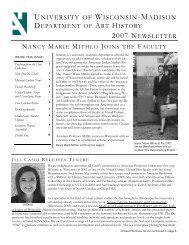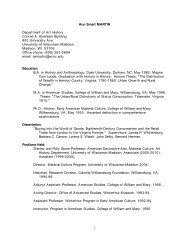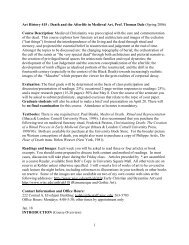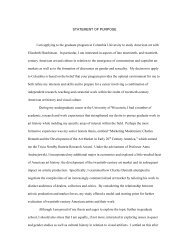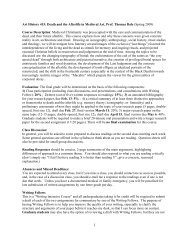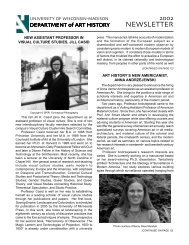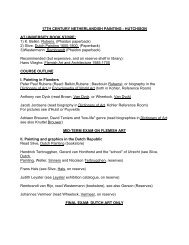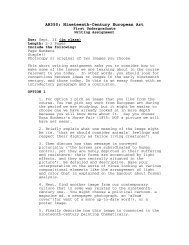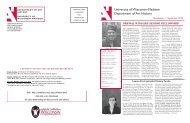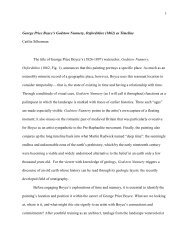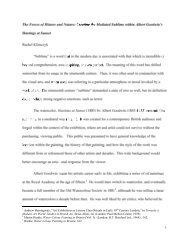Early Christian and Byzantine Art and Architecture - Department of ...
Early Christian and Byzantine Art and Architecture - Department of ...
Early Christian and Byzantine Art and Architecture - Department of ...
You also want an ePaper? Increase the reach of your titles
YUMPU automatically turns print PDFs into web optimized ePapers that Google loves.
<strong>Art</strong> History 310: <strong>Early</strong> <strong>Christian</strong> <strong>and</strong> <strong>Byzantine</strong> <strong>Art</strong> <strong>and</strong> <strong>Architecture</strong> (Spring 2013)<br />
Pr<strong>of</strong>. Thomas Dale, Conrad A. Elvehjem Building, Room 203<br />
Office Hours: Wednesdays, 10:00 a.m. – 12:-00p.m. or at other times by appointment<br />
Telephone: 263-5783; E-mail: tedale@.wisc.edu<br />
Course Description:<br />
This course surveys the art <strong>and</strong> architecture <strong>of</strong> the Mediterranean world from the rise <strong>of</strong> <strong>Christian</strong>ity<br />
within the Roman Empire in the 2 nd <strong>and</strong> 3 rd centuries to the fall <strong>of</strong> the <strong>Byzantine</strong> empire to the Turks in<br />
1453. It is an exciting period which sees the formation <strong>of</strong> a distinctly <strong>Christian</strong> art <strong>and</strong> architecture<br />
drawing upon the religious traditions <strong>of</strong> Judaism <strong>and</strong> pagan Rome on one h<strong>and</strong>, <strong>and</strong> that <strong>of</strong> imperial<br />
rulership on the other. The most significant innovations <strong>of</strong> the period are the invention <strong>of</strong> the parchment<br />
codex–the ancestor <strong>of</strong> the modern book–the creation <strong>of</strong> vast domed spaces for worship on an<br />
unprecedented scale, <strong>and</strong> the innovation <strong>of</strong> a distinctive portrait form still prevalent in the religious<br />
culture <strong>of</strong> Russia <strong>and</strong> much <strong>of</strong> Europe: the icon. We will focus first on the city <strong>of</strong> Rome (between second<br />
<strong>and</strong> fourth centuries) <strong>and</strong> then turn to the <strong>Byzantine</strong> or East Roman Empire centered at Constantinople.<br />
Amongst the high points <strong>of</strong> the course are the catacombs <strong>of</strong> Rome, the mosaics <strong>of</strong> Ravenna, the<br />
architecture <strong>of</strong> Hagia Sophia in Istanbul, the mosaics <strong>and</strong> Pala d’Oro <strong>of</strong> Saint Mark’s in Venice.<br />
Particular emphasis will be placed on the theory <strong>and</strong> function <strong>of</strong> icons or holy images, the use <strong>of</strong> art to<br />
project imperial ideology, the relationship between written texts <strong>and</strong> pictorial narrative, the relationship<br />
between art/architecture <strong>and</strong> ritual, <strong>and</strong> the appropriation <strong>of</strong> <strong>Byzantine</strong> forms <strong>and</strong> iconography for<br />
ideological purposes outside the empire–especially in Italy <strong>and</strong> the Russia—<strong>and</strong> the hybrid culture <strong>of</strong> the<br />
court in Byzantium itself <strong>and</strong> the middle East.<br />
Course Goals:<br />
Like the art <strong>of</strong> other cultures, <strong>Early</strong> <strong>Christian</strong> <strong>and</strong> <strong>Byzantine</strong> art constitute a pictorial language or<br />
“iconography” designed to convey their society’s essential beliefs–religious, social <strong>and</strong> political. The<br />
primary aim <strong>of</strong> this course is to help you comprehend that language, to underst<strong>and</strong> its changing forms<br />
<strong>and</strong> functions <strong>and</strong> the power that it exercised upon the beholder at the time it was created. Exams will test<br />
you not only on your ability to identify works <strong>of</strong> art <strong>and</strong> architecture but also to analyze them in terms <strong>of</strong><br />
their meaning <strong>and</strong> appropriate functional contexts. Assignments are formulated to reinforce the tools <strong>of</strong><br />
iconographical analysis introduced in class <strong>and</strong> to help you read more critically.<br />
Requirements <strong>and</strong> Evaluation<br />
The required texts will provide you with useful background <strong>and</strong> sources <strong>of</strong> illustrations for the images<br />
discussed in class. In order to succeed in this course, you must attend lectures regularly <strong>and</strong> take detailed<br />
notes: you cannot rely upon web-sites <strong>and</strong> textbooks because I will present the material in ways that<br />
depart from the st<strong>and</strong>ard texts.<br />
The final grade will be based on participation (10%), a midterm (25%), a final exam (25%) <strong>and</strong> two short<br />
written assignments (40%). Those students who are interested in substituting a single, longer research<br />
paper for the two shorter assignments should consult the instructor at the beginning <strong>of</strong> the semester. The<br />
quizzes, which will last no more than ten minutes, are designed primarily to help you acquire a strong<br />
visual knowledge <strong>of</strong> the material in the course. You will be required to identify each work <strong>of</strong> art in terms<br />
<strong>of</strong> subject matter (or name <strong>of</strong> a building), location (place <strong>of</strong> origin), date, patron/commissioner, <strong>and</strong><br />
medium. You should also be able to jot down a few points pertaining to the meaning <strong>and</strong> function <strong>of</strong> the<br />
1
work. The midterm will take up an entire class period <strong>and</strong> will cover all <strong>of</strong> the lectures up to <strong>and</strong><br />
including the week before the midterm date. In addition to short answer identifications, you will be<br />
asked to compare <strong>and</strong> contrast works <strong>of</strong> architecture, <strong>and</strong> two write brief essays relating to themes <strong>of</strong><br />
lectures <strong>and</strong> the content <strong>of</strong> assigned readings. Exam make-ups. You must take exams at the time<br />
specified on the syllabus. A postponement <strong>of</strong> the exam will be granted only in the case <strong>of</strong> serious illness<br />
or the death <strong>of</strong> a member <strong>of</strong> your immediate family (I will contact the Dean’s <strong>of</strong>fice for verification).<br />
Under no circumstances will you be allowed to take an exam before the specified time.<br />
Required Texts (available for purchase at the University Book Store, State Street)<br />
John Lowden, <strong>Early</strong> <strong>Christian</strong> <strong>and</strong> <strong>Byzantine</strong> <strong>Architecture</strong> (London: Phaidon, 1998).<br />
Thomas Mathews, The Clash <strong>of</strong> the Gods: A Reinterpretation <strong>of</strong> <strong>Early</strong> <strong>Christian</strong> <strong>Art</strong>, revised ed.<br />
Princeton: Princeton University Press, 1999.<br />
Recommended Texts (available for purchase at University Book Store)<br />
Hans Belting, Likeness <strong>and</strong> Presence (Chicago: University <strong>of</strong> Chicago Press, 1994).<br />
Richard Krautheimer & Slobodan ur i , <strong>Early</strong> <strong>Christian</strong> <strong>and</strong> <strong>Byzantine</strong> <strong>Architecture</strong>, revised ed.<br />
(Harmondsworth: Penguin Books, 1989).<br />
Cyril Mango, The <strong>Art</strong> <strong>of</strong> the <strong>Byzantine</strong> Empire, 312-1453, reprint ed. (Toronto, 1986)<br />
For historical <strong>and</strong> intellectual background to the period covered in the course, you may also wish to read<br />
Cyril Mango, Byzantium. The Empire <strong>of</strong> New Rome (New York, 1980); Judith Herrin, The Formation <strong>of</strong><br />
Christendom (Princeton, 1987); Peter Brown, The Rise <strong>of</strong> Western Christendom, Oxford/Cambridge MA,<br />
1996; Peter Brown, The World <strong>of</strong> Late Antiquity (London, 1989).<br />
Illustrations<br />
A web-site will facilitate your study <strong>of</strong> the visual examples discussed in class <strong>and</strong> to provide a core <strong>of</strong><br />
images that you will be responsible for in examinations. It can be accessed through the <strong>Art</strong> History<br />
<strong>Department</strong> Home-Page via Wisc-World or directly at http://www.arthistory.wisc.edu/ah310/index.html<br />
You will also find all the essential images in the required textbooks <strong>and</strong> readings listed under each lecture<br />
topic below. In addition, I will post my PowerPoint presentations on Learn@UW.<br />
Readings<br />
Readings provide essential background to the lectures <strong>and</strong> points <strong>of</strong> departure for discussion. You will<br />
also be expected to draw upon the content <strong>of</strong> the readings to answer essay questions in your exams. Most<br />
<strong>of</strong> those readings not in the required texts, marked * in the syllabus, are available in the Course Reader,<br />
which can be purchased at Bob’s Copy Shop nearby at 616 University Ave, just a couple <strong>of</strong> blocks east<br />
from the Elvehjem Building. Some materials, marked KL, will only be available in books on reserve at<br />
the Kohler <strong>Art</strong> History Library Reserve Desk. If you need to make a photocopy, please take care not to<br />
damage the book. Additional materials may be provided on Learn@UW.<br />
Calendar<br />
Jan. 22, 24<br />
Introduction<br />
I. Why Images? Pagan, Jewish <strong>and</strong> <strong>Christian</strong> <strong>Art</strong> in the Roman Empire between the 1st <strong>and</strong> 3rd<br />
Centuries<br />
Engraved Gem with IXΘΥC (Ichtheus = fish), Syria/Asia Minor, late 3 rd century (University <strong>of</strong><br />
Pennsylvania Museum <strong>of</strong> Archaeology <strong>and</strong> Anthropology, Philadelphia)<br />
Magical Amulet with Crucifixion <strong>of</strong> Christ, hematite (bloodstone), Syria, late 2 nd to 3 rd century (British<br />
2
Museum, London)<br />
Priscilla Catacomb, Rome, frescoes ca. 200-250<br />
Sarcophagus from Santa Maria Antiqua, Rome, ca. 250<br />
Endymion Sarcophagus, 2nd century (New York, Metropolitan Museum)<br />
Podgoritza bowl, blown glass, Montenegro, 4 th century (State Hermitage Museum, St. Petersburg)<br />
Mithraeum, Dura Europos, Syria (now Yale University <strong>Art</strong> Gallery, New Haven): Cult niche with<br />
gypsum reliefs <strong>of</strong> Mithras slaying the bull, 168 & 170-71 A.D.; painted decoration with deeds <strong>of</strong><br />
Mithras, ca. 250.<br />
Baptistry, The <strong>Christian</strong> Building, Dura Europos, Syria (now in Yale University Museum), architecture<br />
<strong>and</strong> frescoes ca. 254<br />
Synagogue, Dura Europos, frescoes, ca. 200-230<br />
Terms:<br />
sarcophagus; commendatio animae; orant; catacomb; loculus(i); cubiculum(a); arcasolium; refrigerium;<br />
dies natalis; domus ecclesiae; John 10 (The Good Shepherd)<br />
Readings:<br />
KL: Lowden, 4-32; KL: Davis-Weyer, <strong>Early</strong> Medieval <strong>Art</strong>, 3-7; * Robin Jensen, Face to Face: Portraits<br />
o fthe Divine in <strong>Early</strong> <strong>Christian</strong>ity (Minneapolis, 2005), ch. IIII: 69-99 “The Invisible God <strong>and</strong> the<br />
Visible Image.” Jas Elsner, “Cultural Resistance <strong>and</strong> the Visual Image: The Case <strong>of</strong> Dura Europos,”<br />
Classical Philology 95, no. 3 (2001), 269-304. (http://www.jstor.org/stable/1215434)<br />
Discussion:<br />
Why are figural images problematic for Judaism <strong>and</strong> <strong>Christian</strong>ity, <strong>and</strong> to what extent can opposition <strong>of</strong><br />
figural representation be traced within pre-<strong>Christian</strong> Roman religion ? Why did <strong>Christian</strong>ity ab<strong>and</strong>on its<br />
initial opposition to images? What common features are displayed in the figural decoration <strong>of</strong> the<br />
synagogue, <strong>Christian</strong> baptistery <strong>and</strong> pagan temple <strong>of</strong> Mithras at Dura Europos? What explains the<br />
emergence <strong>of</strong> extensive narrative cycles in the synagogue, <strong>and</strong> how, according to Elsner, did Judaism<br />
definie itself in relation to both Roman <strong>and</strong> <strong>Christian</strong> religion through art?<br />
Jan. 29<br />
II. The Emperor Constantine <strong>and</strong> the Conversion <strong>of</strong> Rome in the 4 th Century<br />
Portrait <strong>of</strong> Constantine the Great as Sun-god, Capitoline Museum, Rome<br />
Arch <strong>of</strong> Constantine, Rome, 312-15: marble bas reliefs<br />
Cathedral <strong>of</strong> Saint John Lateran (=San Giovanni in Laterano), Rome, 312/13-18<br />
Basilica <strong>of</strong> Old Saint Peter's, begun, ca. 319/22<br />
Mausoleum <strong>of</strong> Santa Costanza, Rome, ca 350, with mosaics<br />
Sarcophagus <strong>of</strong> Junius Bassus, from transept <strong>of</strong> Old Saint Peter's, 359 (now in the Museum <strong>of</strong> the<br />
Grottoes <strong>of</strong> Saint Peter’s), 359<br />
Missorium <strong>of</strong> Theodosius, silver, (Academia de la Historia, Madrid) 388<br />
Diptych <strong>of</strong> the Nicomachi <strong>and</strong> the Symmachi. ivory (left: N: Musée Cluny, Paris; right: Victoria <strong>and</strong><br />
Albert Museum, London), ca. 380-390<br />
Terms:<br />
Sol invictus; Battle <strong>of</strong> the Milvian Bridge, 312; Edict <strong>of</strong> Milan, 313; basilica; nave; apse; fastigium;<br />
martyrium; transept; burial “ad sanctos”; Ecclesia ex circumcisione (synagogue); Ecclesia ex gentibus<br />
(church <strong>of</strong> the gentiles); typological/christological interpretation<br />
3
Readings:<br />
KL: Lowden, 32-60; Davis-Weyer, <strong>Early</strong> Medieval <strong>Art</strong>, 11-15; *Iohannes Deckers, “Constantine the<br />
Great <strong>and</strong> <strong>Early</strong> <strong>Christian</strong> <strong>Art</strong>,” Picturing the Bible: The Earliest <strong>Christian</strong> <strong>Art</strong>, ed. Jeffrey Spier (New<br />
Haven: 2007), 87-109.<br />
January 31<br />
III. Sacred Space <strong>and</strong> Papal Ideology in Fifth-Century Rome<br />
Santa Pudenziana, apse mosaic, ca. 400<br />
Santa Sabina, Rome, church, mosaics with personifications <strong>of</strong> Church <strong>and</strong> Synagogue, 422-33; wooden<br />
doors with Peter <strong>and</strong> Paul Crowning Ecclesia<br />
Santa Maria Maggiore, Rome, wall mosaics <strong>of</strong> nave <strong>and</strong> triumphal arch, 432-40<br />
Old Saint Peter's, Rome, original wall paintings ca. 375-400<br />
Readings:<br />
Grabar, "The Assimilation <strong>of</strong> Contemporary Imagery," in <strong>Christian</strong> Iconography, 31-54;<br />
Krautheimer/Ćurčić, <strong>Early</strong> <strong>Christian</strong> <strong>and</strong> <strong>Byzantine</strong> <strong>Architecture</strong>, 39-67, 167-74;<br />
Mathews, Clash <strong>of</strong> the Gods, II. 23-53; IV.92-114<br />
Discussion<br />
How does Mathews call into question the traditional concept <strong>of</strong> <strong>Early</strong> <strong>Christian</strong> art as formulated by<br />
Krautheimer <strong>and</strong> Grabar? How might Matthew’s view about the relationship with “imperial” Roman art<br />
be modulated by Deckers’ reading?<br />
Feb. 5<br />
IV. <strong>Art</strong>, <strong>Architecture</strong> <strong>and</strong> Civic Ritual in Constantinople, the “New Rome”<br />
Column <strong>of</strong> Constantine (Cemberlitas= “Burnt Column”)<br />
Coin <strong>of</strong> Constantine as Helios, 337<br />
"Tetrarchs", porphyry, originally from the Philadelphion in Constantinople (now on exterior <strong>of</strong> San<br />
Marco, Venice), ca. 300<br />
Hippodrome (including Obelisk <strong>of</strong> Thutmosis II, 1504-1490 BC, with base set up in 390 AD by<br />
Theodosius I; Bronze serpent column, 479BC?)<br />
Hagia Sophia II, 405-415<br />
L<strong>and</strong>walls <strong>of</strong> Constantinople, built by Theodosius II, 405-13<br />
Readings:<br />
*R. Krautheimer, Three <strong>Christian</strong> Capitals (Berkeley, 1983), 41-67. *Sarah Bassett, “The antiquities in<br />
the Hippodrome <strong>of</strong> Constantinople.” Dumbarton Oaks Papers v. 45 (1991), 87-96.<br />
Feb. 7, 12 (Feb. 12 Meet in Kohler Library to Look at Facsimiles)<br />
V. From Roll to Codex: Text <strong>and</strong> Image in <strong>Byzantine</strong> <strong>and</strong> Late Antique Manuscript Illumination in<br />
the 5th <strong>and</strong> 6th Centuries<br />
Vatican Vergil (Rome, Vatican Library, MS lat. 3225), ca. 400-25: 45v Aeneas <strong>and</strong> Achates approach the<br />
Sibyl; 73v: Trojan Council; 40r: Death <strong>of</strong> Dido<br />
Quedlinburg Itala (Berlin, Deutsche Staatsbibliothek, MS theol. lat. fol. 485<br />
Vienna Genesis (Vienna, Österreichische Nationalbibliothek, MS theol. gr. 31), 6 th century Vienna<br />
Dioscurides (Vienna, Österreichische Nationalbibliothek, MS med. gr. 1), 512, made for Princess<br />
Anicia Juliana<br />
4
Rossano Gospels (Rossanno Cathedral Library)<br />
Rabbula Gospels, 585 (Florence, Laurentian Library, cod. Plutarch I, 56)<br />
Readings:<br />
Lowden, 84-96; *Kurt Weitzmann, “Narration in <strong>Early</strong> Christendom,” American Journal <strong>of</strong> Archaeology<br />
61 (1957):83-91; Herbert L. Kessler, “The Word Made Flesh in <strong>Early</strong> Decorated Bibles,” in Picturing the<br />
Bible, 141-68. Additional illustrations: K. Weitzmann, Late Antique <strong>and</strong> <strong>Early</strong> <strong>Christian</strong> Book<br />
Illumination (New York, 1977)).<br />
Discussion:<br />
What, according to Weitzmann, is the significance <strong>of</strong> the shift from roll to codex in the early centuries <strong>of</strong><br />
the common era? What does he see as the changing relationship between text <strong>and</strong> image? What<br />
conventions <strong>of</strong> pictorial narrative does Weitzmann single out as clues to a lost archetype? What aspects <strong>of</strong><br />
Weitzmann’s theory are challenged by Lowden? How does he see the relationship between monumental<br />
images <strong>and</strong> manuscript illumination in a different way? To what extent does early <strong>Christian</strong> book<br />
illustration draw upon Jewish tradition?<br />
Feb 14 On-line Lecture (Topic VI. No class today)<br />
Feb. 19 Discussion<br />
VI. Baptism, Burial <strong>and</strong> the Afterlife: The <strong>Architecture</strong> <strong>and</strong> Mosaics <strong>of</strong> Ravenna from Galla<br />
Placidia to Theodoric<br />
Oratory <strong>of</strong> Santa Croce, Santi Nazaro e Celso = "Mausoleum <strong>of</strong> Galla Placidia", wall mosaics, ca. 425-50<br />
Baptistery <strong>of</strong> the Cathedral (Orthodox Baptistery): architecture ca 400-50; mosaics, 458<br />
Arian Baptistery, mosaics ca. 500<br />
S. Apollinare Nuovo, architecture, ca. 490; mosaics, 490-500 <strong>and</strong> 550<br />
Readings:<br />
Lowden, 103-116; Davis-Weyer, <strong>Early</strong> Medieval <strong>Art</strong>, 49-53; *Annabel Wharton, “Ritual <strong>and</strong><br />
Reconstructed Meaning: The Neonian Baptistery in Ravenna,” <strong>Art</strong> Bulletin 69 (1987), 358-75.<br />
Discussion:<br />
How do the architecture <strong>and</strong> mosaics <strong>of</strong> Ravenna reinforce the rituals <strong>of</strong> baptism <strong>and</strong> burial? What are the<br />
principles that determine the layout <strong>of</strong> the pictorial programs <strong>of</strong> the mosaics? How does Wharton find<br />
meaning in the specific arrangement <strong>of</strong> themes in the Orthodox Baptistery? How does Matthews call into<br />
question previous interpretations <strong>of</strong> processional images in the Ravenna mosaics in terms <strong>of</strong> imperial<br />
ritual? (Compare his approach to that <strong>of</strong> Wharton).<br />
Feb. 21<br />
VII. <strong>Early</strong> Monastic <strong>Art</strong> <strong>and</strong> <strong>Architecture</strong> in Coptic Egypt<br />
Kellia “The Cells”, cells <strong>of</strong> hermits in Nitrian desert, Egypt, ca. 385-90, 5 th -7 th ; wall paintings with<br />
crosses<br />
White Monastery <strong>of</strong> Shenoute, near Sohag, ca. 450<br />
Monastery <strong>of</strong> Apa Jeremias, Saqqara, ca. 550; portrait paintings <strong>of</strong> monastic saints from cell A, 6 th -7 th<br />
centuries<br />
Monastery <strong>of</strong> Apa Apollo, Bawit, remains ca. 5 th -6 th centuries; paintings 6 th -7 th centuries: Christ in<br />
Majesty with Theotokos <strong>and</strong> apostles<br />
Red Monastery near Sohag, 525-50; with mural paintings <strong>of</strong> Virgin <strong>and</strong> Child; saints<br />
5
Readings:<br />
Krautheimer/Ćurčić, <strong>Early</strong> <strong>Christian</strong> <strong>and</strong> <strong>Byzantine</strong> <strong>Architecture</strong>, 110-117<br />
*Elizabeth S. Bolman “Depicting the kingdom <strong>of</strong> heaven: paintings <strong>and</strong> monastic practice in early<br />
<strong>Byzantine</strong> Egypt” Egypt in the <strong>Byzantine</strong> World, 300-700. Ed. Roger S. BAGNALL. Cambridge:<br />
Cambridge University Press.(2007) 408-433<br />
KL: Elizabeth Bolman, “The White Monastery Federation <strong>and</strong> the Angelic Life,” in Byzantium <strong>and</strong><br />
Islam. Age <strong>of</strong> Transition, 7 th – 9 th century ed. Helen C. Evans & Br<strong>and</strong>ie Ratliff (New York: Metropolitan<br />
Museum <strong>of</strong> <strong>Art</strong>, 2012), 75-77<br />
Feb. 26, 28<br />
VIII. <strong>Art</strong>, <strong>Architecture</strong> <strong>and</strong> Imperial Ritual in Constantinople during the Reign <strong>of</strong> Justinian<br />
***Feb. 28: Assignment 1 Due (Annotated Bibliography & Outline <strong>of</strong> Research paper)***<br />
Hagia Sophia III (Church <strong>of</strong> Holy Wisdom, “The Great Church”), designed by Anthemios <strong>of</strong> Tralles <strong>and</strong><br />
Isidore <strong>of</strong> Miletus, 532-37<br />
Ambo (pulpit) from Beyazit Basilica (now in the Garden <strong>of</strong> Hagia Sophia)<br />
Hagia Eirene, begun 532<br />
Hagios Polyeuktos, built for Anicia Juliana, ca. 524-27 (architectural fragments now in the<br />
Archaeological Museum, Istanbul; “pilastri acritani” now displayed outside the south facade <strong>of</strong><br />
San Marco in Venice)<br />
Saints Sergios <strong>and</strong> Bakchos (known in Turkish as Kucuk Aya Sophia or “Little Hagia Sophia”), built by<br />
Justinian as chapel in the Palace <strong>of</strong> Hormisdas ca. 527-36<br />
Readings:<br />
C. Mango, The <strong>Art</strong> <strong>of</strong> the <strong>Byzantine</strong> Empire, 312-1453. rpt. Toronto, 1986, 72-102; Krautheimer/ ur i ,<br />
<strong>Early</strong> <strong>Christian</strong> <strong>and</strong> <strong>Byzantine</strong> <strong>Architecture</strong>, 205-37; *Bissera Pentcheva, “Hagia Sophia <strong>and</strong><br />
Multisensory Aesthetics,” Gesta 50, no.2 (2011), 93-111.<br />
Discussion:<br />
Paul the Silentiary <strong>and</strong> Procopius have both left (poetic) literary descriptions or “ekphrases” <strong>of</strong> Hagia<br />
Sophia. How do their accounts relate to the actual building? What do they each emphasize? How is the<br />
architecture <strong>of</strong> Hagia Sophia revolutionary in terms <strong>of</strong> its planning <strong>and</strong> spatial organisation? How,<br />
according to Krautheimer, does the building serve the ritual <strong>of</strong> the <strong>Byzantine</strong> church as well as the<br />
imperial entourage?<br />
March 5<br />
IX. Justinianic <strong>Art</strong> in Ravenna: Ritual <strong>and</strong> Politics<br />
San Vitale, Ravenna: architecture, built for Bishops Ecclesius <strong>and</strong> Victor with funding from Julianus<br />
Argentarius ca. 530-45; mosaics made for bishops Victor <strong>and</strong> Maximianus, ca. 540-48<br />
Sant’ Apollinare in Classe, architecture <strong>and</strong> apse mosaic: 532/6-49<br />
Ivory Cathedra (Throne) <strong>of</strong> Maximian, ca 550 (Museo Arcivescovile, Ravenna)<br />
Readings:<br />
Lowden, 116-144; Mathews, The Clash <strong>of</strong> the Gods , 142-176; *C. Barber, “The imperial panels at San<br />
Vitale: a reconsideration,” <strong>Byzantine</strong> <strong>and</strong> Modern Greek Studies 14 (1990), 19-42; *I. Andreescu-<br />
Treadgold <strong>and</strong> Warren Treadgold, “Procopius <strong>and</strong> the Imperial Panels <strong>of</strong> S. Vitale,” <strong>Art</strong> Bulletin LXXIX<br />
(1997), 708-723.<br />
6
Discussion:<br />
How does the architecture <strong>of</strong> San Vitale relate to that <strong>of</strong> Hagia Sophia in Constantinople? What<br />
discrepancies in the planning may be attributed to the different liturgical usage in Ravenna? The mosaics<br />
<strong>of</strong> Justinian <strong>and</strong> Theodora are <strong>of</strong>ten viewed as deliberate statements <strong>of</strong> imperial authority imposed upon<br />
the local population in support <strong>of</strong> Archbishop Maximian (cf. Lowden) <strong>and</strong> further that the apse mosaic<br />
represents a kind <strong>of</strong> parallel to imperial images <strong>of</strong> subjects making <strong>of</strong>ferings to the emperor. How does<br />
Charles Barber use gender theory read the Theodora panel in a new way? How do Andressecu-Treadgold<br />
<strong>and</strong> Treadgold critique previous interpretations <strong>of</strong> the imperial panels? How do they use<br />
archaeological/technical analysis together with texts to support a new identification <strong>of</strong> figures in the<br />
Justinian panel? What crucial changes do they note in the mosaic? Is their argument convincing?<br />
March 7, 12<br />
X. Seeing is believing: The "Loca Sancta" <strong>and</strong> the <strong>Art</strong>s <strong>of</strong> Pilgrimage<br />
Monastery <strong>of</strong> Saint Catherine at Mount Sinai, Egypt, rebuilt by Justinian, ca. 543-65 (including mosaics<br />
<strong>of</strong> Moses <strong>and</strong> the Transfiguration <strong>of</strong> Christ)<br />
Reliquary Box Lid from the Sancta Sanctorum (now Vatican Museums, Rome), 6th-7th centuries<br />
Pewter Pilgrim’s ampulla from Holy L<strong>and</strong> with Crucifixion <strong>and</strong> Resurrection, 6th-7th century<br />
(Dumbarton Oaks, Washington DC)<br />
Pewter Pilgrim’s ampulla showing Crucifixion with kneeling pilgrims <strong>and</strong> Women at Tomb (Monza<br />
Cathedral Treasury, ampulla 13)<br />
Pewter Pilgrim’s ampulla showing Locus Sanctus scenes (Monza Cathedral Treasury, ampulla 2)<br />
Qal’at Sem’an, Shrine <strong>of</strong> Symeon the Stylite the Elder, ca 480-490<br />
Votive plaque silver gilt <strong>of</strong> Symeon Stylites the Elder, 6 th century (Paris, Musée du Louvre)<br />
Terra-cotta Pilgrim’s Token <strong>of</strong> Symeon Stylites the Elder, 6 th - 7 th century (Berlin, Museum für Spätantike<br />
und Byzantinische Kunst–Staatliche Museen)<br />
Basilica <strong>of</strong> Hagios Demetrios, Thessaloniki, architecture, ca. 600; mosaics, ca. 620<br />
Readings:<br />
Jas Elsner, <strong>Art</strong> <strong>and</strong> the Roman Viewer: The Transformation <strong>of</strong> <strong>Art</strong> from the Pagan World to <strong>Christian</strong>ity<br />
(Cambridge, 1995), 97-123; *Gary Vikan, “<strong>Byzantine</strong> Pilgrims’ <strong>Art</strong>,” in Linda Safran, ed. Heaven on<br />
Earth. <strong>Art</strong> <strong>and</strong> the Church in Byzantium (University Park PA, 1998), 229-263.<br />
Discussion:<br />
How does art shape the experience <strong>of</strong> the <strong>Byzantine</strong> pilgrim in different ways? How, according to Elsner,<br />
do the mosaics <strong>of</strong> Sinai (their iconography, placement <strong>and</strong> style) constitute a form <strong>of</strong> visual pilgrimage<br />
that reinforces the symbolic value <strong>of</strong> the pilgrimage site itself? How do the pilgrim’s ampullae <strong>and</strong> the<br />
Sancta Sanctorum reliquary box reinforce the pilgrim’s identification with the events <strong>of</strong> Christ’s life in a<br />
very tangible way once he/she has returned home? What relationship is established here between relic<br />
<strong>and</strong> image?<br />
March 14<br />
XI. Liturgy, Display <strong>and</strong> Ideology: Ivories <strong>and</strong> Silver Vessels <strong>of</strong> the Sixth <strong>and</strong> Seventh Centuries<br />
Shepherd Plate, silver, 527-65 (Saint-Petersburg, Hermitage Museum)<br />
Hercules Plate, silver, 6 th century? (Paris, Bibliothèque Nationale)<br />
Silenus <strong>and</strong> the Maenad, 610-41 (Saint-Petersburg, Hermitage Museum)<br />
Cyprus Plates, originally from Lambousa, 628-30 (New York, Metropolitan Museum & Nicosia,<br />
Archaeological Museum)<br />
7
Kaper Koraon Treasure, buried after 605<br />
Readings:<br />
Lowden, 79-83; *Ruth Leader, “The David Plates Revisited,” <strong>Art</strong> Bulletin 82, no. 3 (2000), 407-427.<br />
Discussion<br />
What purposes do <strong>Byzantine</strong> silver <strong>and</strong> ivory objects serve with the <strong>Byzantine</strong> liturgy? What does<br />
<strong>Byzantine</strong> silver reveal about secular taste <strong>and</strong> continuities with Roman antiquity? How does Leader<br />
critique conventional interpretations <strong>of</strong> the David plates in terms <strong>of</strong> imperial ideology?<br />
March 19<br />
XII. <strong>Early</strong> <strong>Byzantine</strong> Material Culture: Textiles, Amulets <strong>and</strong> Magic<br />
Woolen tapestry hanging with Dionysian deities, from Antinöopolis, ca. 500 (New York, Metropolitan<br />
Museum <strong>of</strong> <strong>Art</strong>)<br />
Linen Tunic with tapestry-woven clavi <strong>and</strong> decorative panels depicting Dionysian motifs, ca. 400-450<br />
(New York, Metropolitan Museum <strong>of</strong> <strong>Art</strong>)<br />
Tapestry-woven hanging <strong>of</strong> Theotokos <strong>and</strong> saints in medallions, 6 th century (Clevel<strong>and</strong> Museum <strong>of</strong> <strong>Art</strong>)<br />
Silk textile roundel with Annunciation, 6 th -8th century (Vatican Museums)<br />
Round tapestry-woven Tunic Ornament with Narrative <strong>of</strong> Joseph, from Achmim, 6th-7th century (Trier,<br />
Städtisches Museum)<br />
Tapestry-woven Tunic roundel with David summoned to be anointed by Samuel,7th-9th century<br />
(Baltimore, Walters <strong>Art</strong> Gallery)<br />
Tapestry-woven Tunic hem with roundel showing David brought before Saul by Samuel half-roundels<br />
showing Holy Riders, 7th-9th century<br />
Silver arm-b<strong>and</strong> with Christological scenes <strong>and</strong> amuletic motifs, 7 th century<br />
Readings:<br />
*H. Maguire, “Garments pleasing to God,” Dumbarton Oaks Papers 44 (1990):215-24; KL: Mango, <strong>Art</strong><br />
<strong>of</strong> the Byz Empire, 50-51; *T. Dale, "The Power <strong>of</strong> the Anointed: The Life <strong>of</strong> David on Two Coptic<br />
Textiles in the Walters <strong>Art</strong> Gallery," Journal <strong>of</strong> the Walters <strong>Art</strong> Gallery 51 (1993):23-42.<br />
Discussion;<br />
To what extent do textiles, <strong>and</strong> the stamped or engraved objects considered here share the iconography <strong>of</strong><br />
works <strong>of</strong> art made for the elite cultures <strong>of</strong> church <strong>and</strong> state, such as manuscript illumination <strong>and</strong> silver?<br />
How is the function <strong>of</strong> narrative transformed by its functional context on clothing or amulets, or as<br />
interior decoration for houses?<br />
March 21<br />
***MIDTERM EXAMINATION (Topics I to XI)***<br />
March 23-31: Spring Break<br />
8
April 2<br />
XIII. Likeness <strong>and</strong> Presence: Portrait Icons before Iconoclasm<br />
Icons from Mt. Sinai: Pantocrator, encaustic on panel, 6th century<br />
Christ–“Semitic Type”, encaustic on panel, 6 th century<br />
Saint Peter with medallions <strong>of</strong> Christ, Mary <strong>and</strong> John the Evangelist, encaustic on panel. 6 th<br />
century<br />
Madonna <strong>and</strong> Child with angels, <strong>and</strong> Saints Theodore <strong>and</strong> George, encaustic on panel,<br />
6th century<br />
Icon <strong>of</strong> Madonna <strong>and</strong> Child from Santa Maria Nova, Rome, 6th century (?)<br />
Icon <strong>of</strong> Enthroned Christ from Sancta Sanctorum, Rome, 7th century?<br />
Madonna della Clemenza, Santa Maria in Trastevere, Rome, 705-07<br />
Later Copies early <strong>Byzantine</strong> types:<br />
Hodegetria, ivory panel from Constantinople, 11 th century copy <strong>of</strong> 5 th -century? type (Utrecht,<br />
Rijksmuseum Het Catherijneconvent)<br />
M<strong>and</strong>ylion (face <strong>of</strong> Christ), San Bartolomeo degli Armeni, Genova, early 14 th century <strong>Byzantine</strong> copy <strong>of</strong><br />
6 th -century? type<br />
M<strong>and</strong>ylion, twelfth-century panel from Novgorod (Moscow, Tretyakov Gallery)<br />
Icon <strong>of</strong> Madonna <strong>and</strong> Child from Santa Maria Nova, Rome, 6th century (?)<br />
Icon <strong>of</strong> Enthroned Christ from Sancta Sanctorum, Rome, 7th century?<br />
Readings:<br />
Belting, 78-114; Mathews, Clash <strong>of</strong> Gods, 177-190. Recommended, especially for illustrations <strong>and</strong><br />
commentaries on individual icons: K. Weitzmann, The Icon ( New York, 1978).<br />
Discussion:<br />
How did the <strong>Early</strong> <strong>Byzantine</strong> Church overcome the traditional Judeo-<strong>Christian</strong> resistance to fashioning<br />
portrait images <strong>of</strong> God <strong>and</strong> holy personages (prophets, saints...)? What continuities from the ancient, pre-<br />
<strong>Christian</strong> cult/ritual <strong>of</strong> images does Belting emphasize? How do Cormack Mathews call into question<br />
traditional interpretations <strong>of</strong> icons <strong>and</strong> their origins?<br />
April 4<br />
XIV. Iconoclasm, the Cult <strong>and</strong> Theory <strong>of</strong> Holy Images<br />
Chludov Psalter, ca. 850 (Moscow, State Historical Museum MS grec. 129)<br />
Hagia Eirene, Constantinople: apse mosaic <strong>of</strong> cross, after 740<br />
Hagia Sophia, Constantinople: inserted cross mosaic in the Seketron, ca. 770<br />
Beresford Hope Cross, ca. 800<br />
Fieschi Morgan Cross Reliquary, cloisonné enamel <strong>and</strong> silver gilt with niello, ca. 800 (New<br />
Readings:<br />
Belting, Likeness <strong>and</strong> Presence, 144-63; Mango, <strong>Art</strong> <strong>of</strong> the Byz Empire, 149-77.<br />
Discussion:<br />
What are the principal causes <strong>of</strong> iconoclasm? What theological arguments do the iconoclasts (opponents<br />
<strong>of</strong> icons) make against holy images <strong>and</strong> what justifications for icons do the iconoduels (proponents <strong>of</strong><br />
9
icons) <strong>of</strong>fer in their defense? Come prepared to take sides <strong>and</strong> debate the merits <strong>of</strong> icons, using the texts<br />
included in Mango’s source collection.<br />
April 9<br />
XV. The Macedonian “Renaissance”, Court <strong>Art</strong> <strong>and</strong> Ideology<br />
Hagia Sophia, Constantinople, mosaics installed 867 by Emperor Basil I (867-86)<br />
Apse mosaic <strong>of</strong> Theotokos; North Tympanum mosaics <strong>of</strong> patriarchs-general view<br />
-mosaics installed under Leo VI (886-912)<br />
-tympanum <strong>of</strong> southwest vestibule: Theotokos enthroned between Justinian <strong>and</strong> Constantine;<br />
narthex mosaic from tympanum over Imperial Door: Christ enthroned between Mary <strong>and</strong> the<br />
Archangel Michael with emperor prostrate<br />
Ivory Sceptre <strong>of</strong> Leo VI, 886-912 (Berlin, Museum für Spätantike und Byzantinische Kunst–Staatliche<br />
Museen)<br />
Ivory plaque showing Constantine VII Porphyrogenitos crowned by Christ, 944-59 (Moscow, Museum <strong>of</strong><br />
Fine <strong>Art</strong>)<br />
Paris Psalter (Paris, Bibliothèque Nationale MS grec. 139), ca. 950-70, made for Constantine VII<br />
Porphyrogenitos (?)<br />
Joshua Roll, ca. 950 (Rome, Vatican Library, MS pal. grec. 431)<br />
Ivory Plaque from rosette casket, ca. 950 (New York, Metropolitan Museum <strong>of</strong> <strong>Art</strong>): Joshua <strong>and</strong> the<br />
Gibeonites<br />
Ivory Plaque <strong>of</strong> the Entry into Jerusalem, ca. 950 (Berlin, Museum für Spätantike und Byzantinische<br />
Kunst–Staatliche Museen)<br />
Ivory Plaque <strong>of</strong> the Washing <strong>of</strong> the Feet, ca. 950 (Berlin, Museum für Spätantike und Byzantinische<br />
Kunst–Staatliche Museen)<br />
Veroli Casket, ivory, ca. 950 (London, Victoria & Albert Museum)<br />
Painted Glass Bowl with classicising medallions, ca. 950 or 12 th century (Venice, Treasury <strong>of</strong> San Marco)<br />
Troyes Casket, ivory casket with hunting scenes, 10 th century<br />
Readings:<br />
K. Weitzmann, "The Character <strong>and</strong> Intellectual Origins <strong>of</strong> the Macedonian Renaissance" in Studies in<br />
Classical <strong>and</strong> <strong>Byzantine</strong> Manuscript Illumination. Chicago, 1971, 176-223; Alicia Walker,<br />
“Appropriation. Stylistic Juxtaposition <strong>and</strong> the Expression <strong>of</strong> Power,” in the Emperor <strong>and</strong> the World.<br />
Exotic Elements <strong>and</strong> the Imaging <strong>of</strong> Middle <strong>Byzantine</strong> Imperial Power (Cambridge, 2012), 45-79.<br />
Discussion:<br />
How do the accounts <strong>of</strong> the Macedonian “Renaissance” <strong>of</strong>fered by Weitzmann <strong>and</strong> Webb differ in<br />
method <strong>and</strong> argument? To what extent do both style <strong>and</strong> content inform <strong>Byzantine</strong> imperial ideology?<br />
April 11<br />
XVI. "Icons in Space": Middle <strong>Byzantine</strong> Church Decoration<br />
Monastery <strong>of</strong> Hosios Loukas, Katholikon, architecture <strong>and</strong> mosaics, early 11 th century (before 1048)<br />
Ochrid, H. Sophia, apse, ca. 1050<br />
Monastery <strong>of</strong> the Koimesis, Daphni (near Athens), ca. 1100<br />
Church <strong>of</strong> Saint George at Kurbinovo, Yugoslav Macedonia, ca. 1190<br />
10
Harbaville Triptych, ivory, 10 th century (Paris, Musée du Louvre): Deesis <strong>and</strong> saints<br />
Ivory diptych with “Dodekaorton” or Twelve Feasts, 11 th century (Saint Petersburg, Hermitage Museum)<br />
Menologion <strong>of</strong> Basil II, ca. 1000 (Rome, Vatican Library, MS grec. 1613), fol. 299v: Baptism<br />
Gospel Book, ca. 1100 (Parma, Biblioteca Palatina)<br />
Iconostasis Beam, tempera <strong>and</strong> gold leaf on panel: Deesis <strong>and</strong> Twelve Feasts (Monastery <strong>of</strong> St. Catherine,<br />
Mt. Sinai), twelfth-century<br />
Iconostasis Beam in enamel, originally from Constantinople (Pantokrator Monastery?), twelfth century<br />
(now forming upper zone <strong>of</strong> Pala d’Oro, San Marco, Venice)<br />
Reading:<br />
KL: Lowden, 229-270; KL: O. Demus, <strong>Byzantine</strong> Mosaic Decoration (London, 1948), 3-39; *T.<br />
Mathews, "The Transformation Symbolism in <strong>Byzantine</strong> <strong>Architecture</strong> <strong>and</strong> the Meaning <strong>of</strong> the Pantokrator<br />
in the Dome," in Church <strong>and</strong> People in Byzantium, ed., R. Morris (Birmingham, 1990), 191-214. *C.<br />
Barber, "From Transformation to Desire: <strong>Art</strong> <strong>and</strong> Worship after <strong>Byzantine</strong> Iconoclasm," <strong>Art</strong> Bulletin 75<br />
(1993):7-16<br />
Discussion:<br />
How does Otto Demus define the “classical system” <strong>of</strong> Middle <strong>Byzantine</strong> church decoration, <strong>and</strong> what<br />
essential relationships does he establish between art <strong>and</strong> architectural space/ art <strong>and</strong> the beholder? How<br />
does Mathews critique Demus <strong>and</strong> attempt to redefine the nature <strong>of</strong> Middle <strong>Byzantine</strong> church decoration;<br />
what does he see as the essential function <strong>of</strong> the Pantocrator in the dome vis-à-vis the spectator? How<br />
does Barber call into question Mathews’ interpretation <strong>of</strong> the Pantocrator?<br />
April 16<br />
XVII. Late Antique, <strong>Byzantine</strong> <strong>and</strong> Russian Orthodox <strong>Art</strong> in the Chazen<br />
(Meet in Gallery I on second floor <strong>of</strong> Elvehjem Building, accessed from Paige Court)<br />
April 18, 23, 25<br />
XVIII. Middle <strong>Byzantine</strong> Programmes in Foreign Courts<br />
1) Building “Heaven on Earth” in the Kievan Rus<br />
Hagia Sophia, Kiev, constructed under Yaroslav the Wise (1019-54)<br />
St. Demetrios, Vladimir, 1193-97<br />
Reading: KL Olenka Pevny, “Kievan Rus” in The Glory <strong>of</strong> Byzantium, 281-286<br />
2) <strong>Byzantine</strong> Court Culture in Norman Sicily<br />
Palermo, Cappella Palatina: architecture <strong>and</strong> mosaics <strong>of</strong> the dome <strong>and</strong> transept, under Roger II, 1140-43.<br />
Martorana (St. Mary <strong>of</strong> the Admiral), Palermo: architecture <strong>and</strong> mosaics, for George <strong>of</strong> Antioch, ca. 1143<br />
Cefalù Cathedral, sanctuary mosaics, 1148<br />
Readings: KL: Lowden, 309-346; *W. Tronzo, “"The Medieval Object-Enigma <strong>and</strong> the Problem <strong>of</strong><br />
the Cappella Palatina in. Palermo," Word <strong>and</strong> Image 9 (1993), 197-228.<br />
3) Appropriation <strong>and</strong> Adaptation in Medieval Venice<br />
11
Basilica <strong>of</strong> San Marco (the Ducal Chapel), Venice: architecture mainly completed 1094 (facade after<br />
1204)<br />
Readings: KL: Belting, 195-207; *Thomas Dale, “Cultural Hybridity in Medieval Venice<br />
Reinventing the East at San Marco after the Fourth Crusade,” in San Marco, Byzantium <strong>and</strong> the myths <strong>of</strong><br />
Venice, ed. H. Maguire <strong>and</strong> Robert S. Nelson (Washington, D. C.: Dumbarton Oaks, 2010), 151-191.<br />
Discussion:<br />
How is Middle <strong>Byzantine</strong> church decoration adapted in different for specific ideological <strong>and</strong> religious<br />
reasons in the courts <strong>of</strong> the Kievan Rus, Norman Sicily <strong>and</strong> Venice? What distinctive meanings does<br />
“cultural hybridity” have <strong>and</strong> how is the concept applied differently by Tronzo <strong>and</strong> Dale? How do<br />
Tronzo <strong>and</strong> Dale take into account specific aspects <strong>of</strong> court ritual <strong>and</strong> privileged viewing in their<br />
interpretations?<br />
April 30<br />
XIX. Crusader <strong>Art</strong> <strong>and</strong> Cultural Hybridity in the Holy L<strong>and</strong><br />
KL: Glory <strong>of</strong> Byzantium, 389-401; Eva H<strong>of</strong>fman, “<strong>Christian</strong>-Islamic Encounters on Thirteenth-century<br />
Ayyubid Metalwork: Local Culture, Authenticity <strong>and</strong> Memory,” Gesta XLIII/2 (2004):129-142 (online at<br />
http://www.jstor.org.ezproxy.library.wisc.edu/stable/pdfplus/25067100.pdf)<br />
Maria Georgopoulou, “Orientalism <strong>and</strong> Crusader <strong>Art</strong>: Constructing a New Canon,” Medieval Encounters<br />
5, no. 3 (1999): 289-321 (online through MadCat).<br />
Discussion:<br />
How is “Crusader <strong>Art</strong>” usually defined? How do the metalwork <strong>and</strong> glass objects studied by Eva<br />
H<strong>of</strong>fmann <strong>and</strong> Maria Georgopoulou further complicate the definition <strong>of</strong> “Crusader <strong>Art</strong>” in terms <strong>of</strong><br />
production <strong>and</strong> intended audiences? How does Georgopoulou adapt Said’s concept <strong>of</strong> Orientalism to<br />
medieval Crusader <strong>Art</strong>?<br />
May 2<br />
XX. The Shroud <strong>of</strong> Turin <strong>and</strong> Liturgical Images <strong>of</strong> the Passion<br />
***Assignment 2 due***<br />
Shroud <strong>of</strong> Turin, <strong>Byzantine</strong> textile icon, early 14 th century Constantinople (now in Turin Cathedral)<br />
Saint Panteleimon, Nerezi (Yugoslav Republic <strong>of</strong> Macedonia), mural paintings, 1164<br />
-Deposition <strong>and</strong> Threnos/Entombment <strong>of</strong> Christ<br />
“Our Lady <strong>of</strong> Vladimir”, icon <strong>of</strong> Virgin & Child “Eleousa”, 12 th century, Constantinople (now Tretyakov<br />
Gallery, Moscow); back <strong>of</strong> icon showing Arma Christi<br />
Double-sided icon from Kastoria, 12 th century: Hodegetria (front); Man <strong>of</strong> Sorrows (back)<br />
Saint George, Kurbinovo (Yugoslav Republic <strong>of</strong> Macedonia), mural paintings, 1191<br />
-Threnos; apse showing con-celebration <strong>of</strong> bishops <strong>and</strong> Amons Aer<br />
King Abgar with the M<strong>and</strong>ylion, icon, St. Catherine’s, Mt. Sinai, ca. 950<br />
Burial Shroud <strong>of</strong> King Milutin <strong>of</strong> Serbia (Belgrade, Museum <strong>of</strong> Church <strong>Art</strong>)<br />
Readings:<br />
12
*W. Dale, "The Shroud <strong>of</strong> Turin: Icon or Relic?" Nuclear Instruments & Methods in Physics Research 29<br />
(1987): 187-192; KL: S. ur i , "Late <strong>Byzantine</strong> 'Loca Sancta'? Some Questions Regarding Form <strong>and</strong><br />
Function <strong>of</strong> Epitaphioi," in Twilight <strong>of</strong> Byzantium. Princeton, 1991, 251-61.<br />
Discussion:<br />
Why does Dale argue that the traditional question <strong>of</strong> the authenticity <strong>of</strong> the shroud <strong>of</strong> Turin is a false one<br />
<strong>and</strong> how does he redefine the terms <strong>of</strong> debate? How did the image <strong>of</strong> the Threnos emerge <strong>and</strong> how did it<br />
prepare the way for a full-length image <strong>of</strong> the body <strong>of</strong> Christ? How does ur i explain the function <strong>of</strong><br />
related images on epitaphioi?<br />
May 7, 9<br />
XXI. The Palaeologan Renaissance <strong>and</strong> the Collapse <strong>of</strong> the Empire<br />
Deesis mosaic, Hagia Sophia, Istanbul, south gallery, ca. 1205 or 1261?<br />
Tekfur Saray (so-called “Palace <strong>of</strong> Constantine Porphyrogenitos”), extension <strong>of</strong> Blachernae Palace,<br />
Istanbul, ca. 1350<br />
Fethiye Djami (St. Mary Pammakaristos), Istanbul, 1315 under Andronikos II<br />
Monastery <strong>of</strong> Gracanica (Serbia), pre-1321 for King Milutin<br />
Kariye Djami (Monastery <strong>of</strong> the Savior in the Chora), Istanbul: architecture <strong>of</strong> naos, ca. 1077-81 under<br />
Maria Ducas <strong>and</strong> restoration ca. 1100 under Isaac Comnenos; architecture <strong>of</strong> outer narthex <strong>and</strong><br />
parekklesion <strong>and</strong> decoration (mosaics <strong>and</strong> frescoes), 1316-21 under Theodore Metochites<br />
Readings:<br />
KL: Lowden, 389-424; KL: Krautheimer/ ur i , <strong>Early</strong> <strong>Christian</strong> & <strong>Byzantine</strong> <strong>Architecture</strong>, 413-50 (esp.<br />
440ff);<br />
Discussion:<br />
What impact did the political <strong>and</strong> religious climate <strong>of</strong> the late <strong>Byzantine</strong> empire have on the appearance<br />
<strong>of</strong> <strong>Byzantine</strong> art <strong>and</strong> architecture? What role is played by private patrons?<br />
***Saturday May 18 at 10:05 a.m. to 12:05 pm: FINAL EXAM****<br />
13



